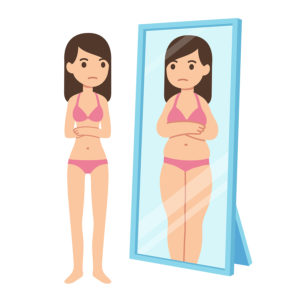Eating Disorders – More Than Meets the Eye

“You must be crazy! How do you not see that you aren’t fat?”, “you’re being ridiculous!”, “just stop it!”. She’d heard it all before. They didn’t understand. Looking in the mirror, all she could see were flaws. Fat, ugly, bad skin, wrong shape, just plain hideous. She checked the scale again. “Tomorrow I will only eat half the apple,” she thought. This self-torture was a familiar one. It almost brought her comfort – at least she had a plan! Her friends keep saying she looks fine, but she knows they are lying. I mean, look at that reflection! Time to go do some crunches. Again.
These are just some of the types of thoughts someone struggling with an eating disorder fights with almost constantly. Thankfully, there is proven help available. Eating disorders can be overcome!
People often assume eating disorders are influenced by desires to lose weight or to meet social expectations. While these assumptions can be correct, there can be many other factors that contribute to the development of an eating disorder. Most commonly known are likely Anorexia Nervosa, Bulimia Nervosa, and Binge Eating Disorder. Although these disorders affect many, eating disorders are not limited to these three types. Orthorexia (obsession with healthful eating), Laxative Abuse, and Compulsive Exercise are other forms of eating disorders.
Although eating disorders are associated with body image, the cause of them is not always triggered by concerns of weight or influenced by an external source such as social media. There is evidence that eating disorders can stem from trauma or PTSD [i]. According to a study conducted by the Departments of Psychology at two universities in Italy, the majority of individuals diagnosed with Anorexia Nervosa, Bulimia Nervosa, and Binge Eating Disorder had some sort of interpersonal trauma in their past [ii]. Uncovering the traumatic event in affected individuals can prove to be a challenge as individuals with eating disorders demonstrate high levels of dissociative symptoms (a type of forgetfulness or shutting down), which causes them to be unable to remember the traumatic event. Behaviors such as binge eating and purging, while unhealthy, reduce the anxiety or physiological arousal associated with trauma and can result in effects of numbing, avoidance and forgetting of traumatic experiences. Eating disorders and the behaviors associated with each specific disorder can be challenging to break due to the fact that the thoughts, emotions, and behaviors reinforce one another which often leads to a perpetual cycle.
With this information in mind, it is important to note that eating disorders can be successfully treated with the help of certain therapeutic approaches. One such approach is Enhanced Cognitive Behavioral Therapy (CBT-E). CBT-E helps to identify the relationship between thoughts, feelings, and behaviors and how thought processes lead to particular actions and behaviors. The techniques and treatment plans of CBT-E use tools and exercises to help bring awareness to emotional and behavioral patterns and to help the individual acquire new coping skills.
If you or someone you love is struggling with an eating disorder, there is hope! Harmful habits can be overcome, healing from past traumas can be found, and changes can be made. While some can be overcome with help from family and friends, many people often need to seek professional help. And the good news is that it works! Professionally trained therapists have shown time and time again that eating disorders can be overcome. If you or someone you love is struggling with an eating disorder, know that there is hope. Don’t wait, get help. Eating disorders can be overcome!
-Sarah Vermunt, MFTI
—————————-
[i] National Eating Disorder Association
[ii]Palmisano, G. L., Innamorati, M., Susca, G., Traetta, D., Sarracino, D., & Vanderlinden, J. (2018). Childhood traumatic experiences and dissociative phenomena in eating disorders: Level and association with the severity of binge eating symptoms. Journal Of Trauma & Dissociation, 19(1), 88-107. doi:10.1080/15299732.2017.1304490
